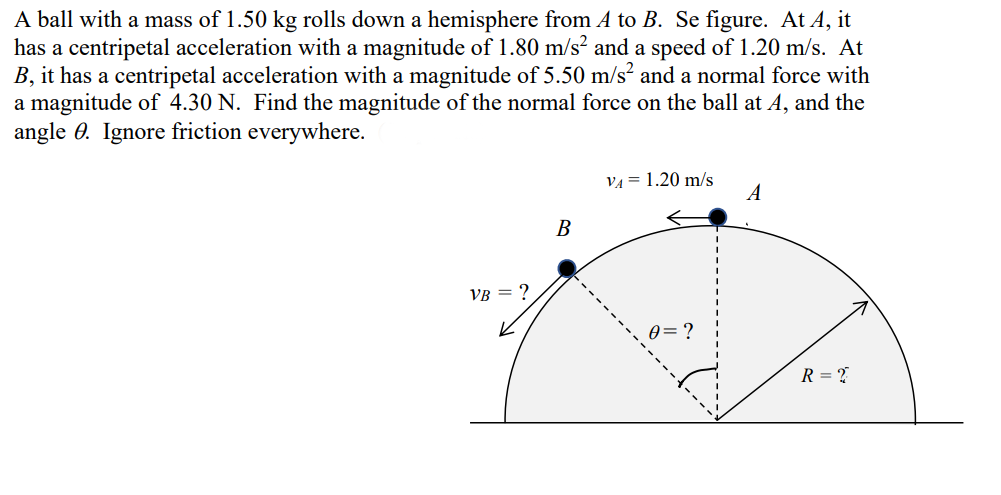A ball with a mass of 1.50 kg rolls down a hemisphere from A to B. Se figure. At A, it has a centripetal acceleration with a magnitude of 1.80 m/s² and a speed of 1.20 m/s. At B, it has a centripetal acceleration with a magnitude of 5.50 m/s? and a normal force with a magnitude of 4.30 N. Find the magnitude of the normal force on the ball at A, and the angle 0. Ignore friction everywhere. VA = 1.20 m/s В VB = ? 0= ? R = ?
A ball with a mass of 1.50 kg rolls down a hemisphere from A to B. Se figure. At A, it has a centripetal acceleration with a magnitude of 1.80 m/s² and a speed of 1.20 m/s. At B, it has a centripetal acceleration with a magnitude of 5.50 m/s? and a normal force with a magnitude of 4.30 N. Find the magnitude of the normal force on the ball at A, and the angle 0. Ignore friction everywhere. VA = 1.20 m/s В VB = ? 0= ? R = ?
Physics for Scientists and Engineers: Foundations and Connections
1st Edition
ISBN:9781133939146
Author:Katz, Debora M.
Publisher:Katz, Debora M.
Chapter7: Gravity
Section: Chapter Questions
Problem 38PQ
Related questions
Question

Transcribed Image Text:A ball with a mass of 1.50 kg rolls down a hemisphere from A to B. Se figure. At A, it
has a centripetal acceleration with a magnitude of 1.80 m/s² and a speed of 1.20 m/s. At
B, it has a centripetal acceleration with a magnitude of 5.50 m/s? and a normal force with
a magnitude of 4.30 N. Find the magnitude of the normal force on the ball at A, and the
angle 0. Ignore friction everywhere.
VA = 1.20 m/s
В
VB = ?
0= ?
R = ?
Expert Solution
This question has been solved!
Explore an expertly crafted, step-by-step solution for a thorough understanding of key concepts.
Step by step
Solved in 3 steps

Recommended textbooks for you

Physics for Scientists and Engineers: Foundations…
Physics
ISBN:
9781133939146
Author:
Katz, Debora M.
Publisher:
Cengage Learning

Physics for Scientists and Engineers: Foundations…
Physics
ISBN:
9781133939146
Author:
Katz, Debora M.
Publisher:
Cengage Learning